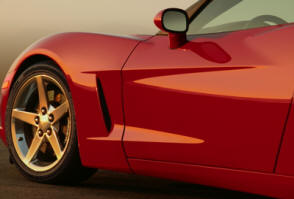Tire Pressure Monitoring System and Competition Use of a
Corvette
 The
Corvette is equipped with the latest in tire pressure monitoring
hardware and software. Each wheel has a sensor mounted in it that
transmits electronic signals through the air to a Tire Pressure
Monitor (TPM) Receiver. The system is designed to monitor tire
pressure and alert you if conditions warrant your attention or
action.
The
Corvette is equipped with the latest in tire pressure monitoring
hardware and software. Each wheel has a sensor mounted in it that
transmits electronic signals through the air to a Tire Pressure
Monitor (TPM) Receiver. The system is designed to monitor tire
pressure and alert you if conditions warrant your attention or
action.
The TPM
Receiver looks for the production sensors to check in for each
corner. If the production sensors are removed, the receiver will
start a counter that adds up time driven above 20 kph without TPM
signals. This counter is reset at each key cycle until the time is
reached. After a total of 60 minutes* cumulative time (above 20 kph
in that key cycle) it will set a TPM fault. You can slow down or
stop during this period, but the counter only runs when vehicle is
exceeding 20 kph. The DIC will then display "Service Tire Monitor"
and the pressures will display XXX for each corner. Once the “TPM
fault” has been set, you will be able to continue to disable
traction and stability for the lifetime of the car, as long as the
original programmed sensors are nowhere near the car. If a master
power kill switch is utilized, the system is reset and the driving
process must be repeated to set the TPM fault. Some owners install
partial kill switches that maintain power to vehicle computers. To
maintain the TPM fault, power must be maintained to fuse #11 in the
underhood fuse center.
*The
60-minute timer applies to 2005 Corvettes. For 2006 it is reduced
to 30 minutes, and for 2007 it will be less than 20 minutes. Be
warned that sometimes the sensors can be picked up from as far away
as 50 feet. We recommend keeping the TPM sensors far away from the
vehicle. Leave them at home.
 During
the time that the counter is accumulating with no sensors checking
in, you can still turn off stability and traction control normally.
As long as all four corners go invalid at the same time, you can
continue to disable stability and traction control as you would
normally, even after the timer sets the fault. One minor exception
is that if the corners are considered by the TPM Receiver to be
"invalid" a few seconds apart, it might turn stability on
momentarily when the timer expires, but it can then be manually
switched off with the button.
During
the time that the counter is accumulating with no sensors checking
in, you can still turn off stability and traction control normally.
As long as all four corners go invalid at the same time, you can
continue to disable stability and traction control as you would
normally, even after the timer sets the fault. One minor exception
is that if the corners are considered by the TPM Receiver to be
"invalid" a few seconds apart, it might turn stability on
momentarily when the timer expires, but it can then be manually
switched off with the button.
Stability and traction can be switched off as long as
either all four programmed sensors are present, or none of the
sensors are present. If 1, 2 or 3 sensors are detected at the
corner they have been programmed, then the system will go into
flat-tire mode. This is an aggressive stability function, cannot be
switched off, and Competitive Mode is not available.
Autocrossers should be able to get away with swapping
wheels and never reaching the timers. They will want to make sure
the stock wheels and sensors are put somewhere far away before
keying up, so they don't accidentally pick up 1, 2 or 3 signals.
Open track-day participants might reach the timers and set the TPM
fault. They can still continue normally but might be surprised by
the message. When it's time to go home, as long as the stock wheels
go back on in the correct location (corner for corner), the sensors
will start working again and all will be well. Road racers probably
want to get rid of the sensors and keep them away from the car
altogether. As an alternative, a racer could keep the sensors in
the race wheels, to help keep an eye on things during a race. Note
some sensors may saturate above 50 psi and return to normal as
pressures decrease. A second set of sensors could be used as long
as they were retrained to function as designed per the owner’s
manual.


